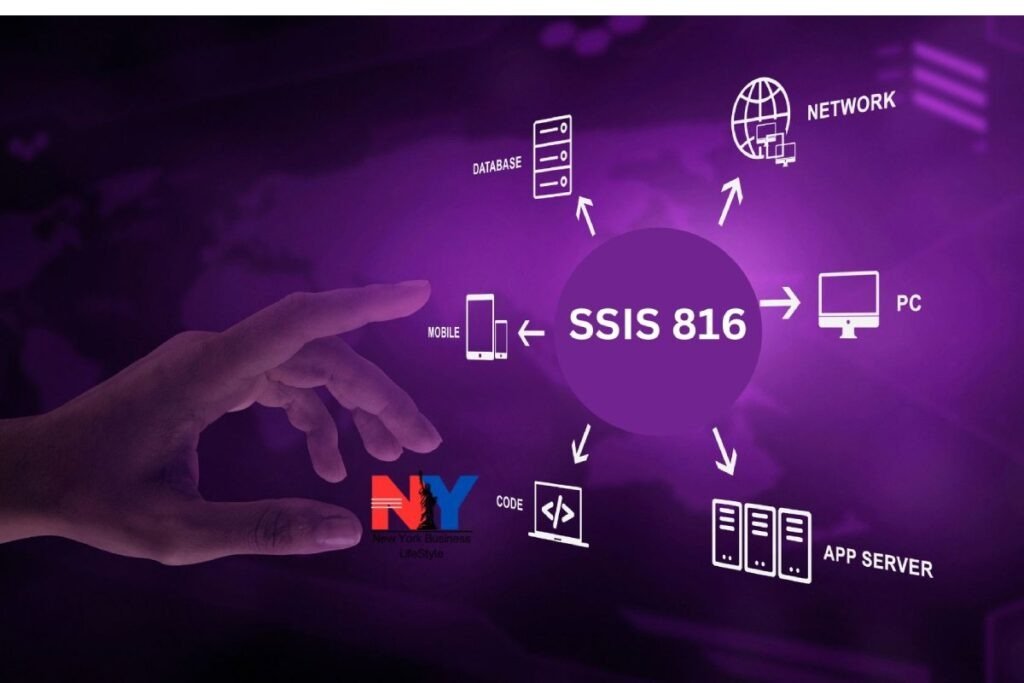An important step forward in data management solution advancement is SSIS 816. It adds innovative features that meet the changing demands of modern enterprises while expanding upon the strong base of its predecessors. The way enterprises handle their data assets is about to be transformed by SSIS’816 and its revolutionary performance capabilities and advanced security features.
Explain SSIS 816?
One of Microsoft’s many data integration tools is SSIS 816, which stands for SQL Server Integration Services. Businesses of all sizes rely on it for a smooth integration experience, which it provides by quickly managing, retrieving, and processing data from diverse sources.
Important Functions and Features:

- Connecting to Multiple Data Sources:
Numerous data sources can be connected to using SSIS 816. These include web services, flat files, cloud platforms (Azure SQL Database, Amazon Redshift), and databases (SQL Server, Oracle, MySQL). Data extraction from diverse situations is made easy with this adaptability.
- Superior Transformative Choices:
The essence of SSIS 816 is data transformation. It has a lot of transformations already built in, like the ability to sort, aggregate, merge, and clean data. It is also possible to incorporate third-party components and bespoke scripts to meet the needs of individual businesses.
- Improving Performance and Scalability:
Efficiently manage massive amounts of data with SSIS 816’s expanded performance tweaking capabilities and increased parallelism. Data partitioning, improved data flow pipelines, and parallel job execution are all features that can be used to reduce processing time and increase throughput.
- Strong Data Governance and Quality:
Crucial components of data management include guaranteeing quality and preserving data integrity. In order to ensure that data meets quality criteria, SSIS 816 includes tools for data cleansing, validation, and profiling. For regulatory and oversight reasons, it likewise facilitates auditing and logging systems.
- Deploying and managing in a flexible manner:
You can choose from on-premises, cloud, or hybrid deployment options with SSIS 816. The ability to install and manage ETL operations across distributed infrastructures is made easier by integration with Azure Data Factory and other Microsoft cloud services.
Data Transformation and Advanced Cleaning
An essential part of any successful information mix strategy is data quality. SSIS 816 is a powerful data cleansing and transformation tool that lets customers secure, cleanse, and enhance data as it flows through the integration cycle. This will ensure that the data used to make business decisions is accurate and reliable.
Strong Safety Procedures:

Anybody dealing with data combination should prioritize security. In order to keep sensitive data secure, SSIS 816 is equipped with robust security measures. First, we have access restriction and encryption. Using this version, you can be certain that the reconciliation interaction will keep your information safe.
The Advantages of SSIS 816:
Full-Fledged Data Integration:
- Many Different Types of Data:
Many different types of data sources can be accessed with SSIS, such as relational databases, flat files, Excel spreadsheets, and many more. Complex data integration activities are well-suited to it because of this.
- Data Conversion:
When you use its robust data transformation capabilities, you can clean, consolidate, and otherwise modify data before loading it into a destination.
Ability to Extract, Transform, and Load:
- Procedures for ETL Efficiency:
SSIS is great at gathering information from many sources, cleaning it up so it meets business requirements, and then feeding it into a data warehouse or other destination system.
- Enhancing Performance:
Data flow buffers and parallel processing are two of its features that can improve ETL performance.
Automating Workflows:
- Automating Tasks:
Tasks as varied as handling file transfers, executing stored procedures, and SQL script execution are all within your reach with automation.
- Appointed Tasks:
Scheduled execution of SSIS packages allows for the automated handling of data integration procedures.
Logging and Handling Errors:

- Strong Handling of Errors:
When problems emerge while processing data, SSIS’s sophisticated error handling and logging capabilities come in handy.
- Precise Record-Keeping:
You can set up logging to record specifics about how SSIS packages run, which aids in troubleshooting and monitoring.
Interface Design for Ease of Use:
- Graphic Designer:
The SQL Server Data Tools graphical user interface is an integral part of SSIS and makes it easy to manage and create data integration tasks with a simple drag-and-drop method.
- Ready-to-use Parts:
You won’t need to write as much code because it comes with so many pre-built components and transforms.
Enhancing Performance and Scalability:
- Ability to scale:
With SSIS, you can manage massive amounts of data and expand it as your company grows.
- Optimizing Performance:
Data integration operations can be made more efficient with features like buffer management and data flow optimization.
Connectivity to the SQL Server Network:
- Integrating Without a Hitch:
SSIS is an ideal companion for SQL Server settings due to its seamless integration with other SQL Server ecosystem components.
- Warehouse for Data:
Data warehousing scenarios frequently employ it to bolster massive data transformation and integration initiatives.
Protection Mechanisms:
- Security of Data:
When transferring or storing sensitive information, SSIS gives you the option to encrypt it.
- Controlling Access:
To make sure that only authorized users may run and manage SSIS packages, you can set up permissions and access controls.
Controlling Versions and Deploying:
- Control of Versions:
You can keep track of changes and manage different versions of SSIS packages with SSIS’s support for version control systems.
- Adaptability during Deployment:
Making use of the resources offered by the SQL Server ecosystem, you may deploy SSIS packages to various environments, including development, testing, and production.
Wide applicability:
- Individualized Parts:
To go beyond what is already available in SSIS, developers have the option to design their own new components and tasks.
Script Tasks:
- You can create custom code in C# or VB.NET for specialized processing using the script tasks and components that are part of SSIS.
Practical Uses and Economic Benefits:
Domain-Related Use Cases
- Medical treatment:
The healthcare business can utilize SSIS 816 to combine patient data from multiple sources, guaranteeing thorough and precise medical records. Important for managing and caring for patients, it allows data processing in real-time, which means decisions may be made faster.
- Economic planning:
Integrating transaction data, risk management systems, and compliance reporting is made easier with SSIS 816 in the financial sector. Financial institutions can control risk and maintain regulatory compliance with its real-time insights and ability to handle enormous datasets.
- Retail:
By combining customer, inventory, and sales data from several sources, SSIS 816 helps retail companies. Improved demand forecasting, targeted marketing, and streamlined inventory management are all made possible by this combination.
- Manufacturing:
By integrating manufacturing data, streamlining supply chain operations, and optimizing resource use, SSIS 816 can help manufacturers. Keeping tabs on production processes in real-time and enhancing operational efficiency are both helped by this.
Enhancements to SSIS 816’s security:
Without a doubt, in today’s data-driven world, security is of the utmost importance, and SSIS816 elevates the game by providing users with enhanced security features. Users may protect sensitive data assets with its encryption method, fine-grained access control, and other comprehensive security features. The solution guarantees that user data is always protected with support for industry-standard encryption techniques and smooth integration.
How Does SSIS 816 Improve Data Integration?
Today, in the age of big data, companies must figure out how to effectively manage enormous amounts of data. When called upon, SSIS 816 provides a simplified method of data integration. When it comes to processing real-time data, connecting to cloud-based services, or assuring data quality, SSIS 816 is a dependable solution.
Configuration and Installation:
Starting to use SSIS 816 couldn’t be easier. To ensure the tool runs at its best after installation and configuration, follow these steps:
- Get the SSIS 816 setup file from Microsoft’s main website.
- To finish the installation, launch the installer and adhere to the on-screen prompts.
- Adjust the SSIS 816 parameters so they meet the needs of your company.
Guidelines for Successfully Applying:
It is critical to adhere to best practices during implementation in order to get the most out of it. Here are a few fundamental guidelines:
- The process of conceptualizing and designing:
It is critical to meticulously plan and develop the ETL operations before to implementation. This necessitates familiarity with the data sources, necessary changes, and final destinations. Issues that may arise during implementation can be mitigated with careful preparation.
- Maximize ETL Efficiency:
Improving performance is impossible without optimizing ETL operations. Among these tasks is the selection of appropriate data sources, the reduction of data movement, and the application of effective transformation methods. Data segmentation and indexing correctly can also improve performance.
- Oversee and Upkeep:
For SSIS packages to run smoothly, regular monitoring and maintenance are required. Among these tasks is keeping an eye on performance, making sure nothing is amiss, and applying any required changes. Rapid problem identification and resolution are both facilitated by automated monitoring tools.
- Informational materials:
For the sake of future reference and troubleshooting, it is essential that SSIS packages be properly documented. Included in this documentation should be the ETL procedures, data sources, transformations, and any bespoke code that was employed. The ease of maintenance and updates to the packages is dependent on good documentation.
- Safety measures:
It is of the utmost importance to guarantee data security throughout ETL processes. Data encryption while in motion and at rest, access limits, and routine security audits are all part of this. Secure data can be better protected with the use of upgraded security measures.
Data Integration and SSIS in the Future:
“Emerging technologies such as cloud computing, AI, and real-time analytics are going to have a major impact on the future of SSIS and data integration. To meet the complex and ever-increasing demands of modern enterprises, SSIS is anticipated to incorporate more advanced capabilities as these technologies improve. This will result in data management systems that are even more advanced, efficient, and agile.
- New Directions in Integrating Data:
It is critical to be aware of the tendencies that will determine the fate of data integration in the years after 2024. Integration with the cloud, real-time processing of data, and the impact of big data are just a few of the new technologies and approaches that will shape the future of tools like SSIS, and this chapter will delve into them.
- A Critical Function of SSIS in Contemporary Data Strategy:
Here we’ll go into how SSIS 816 fits into the bigger picture of modern data management and analytics plans. It will go over the many ways SSIS may be used, from BI to data research, and how it is part of the bigger picture of data ecosystems.
- Future Expectations of SSIS After 2024:
Finally, we will take a shot at SSIS’s potential future after 2024. As part of this process, we will make educated guesses about possible upgrades, how SSIS might adapt to incorporate new technology, and how data integration and administration will change in the future.
In summary:
To sum up, SSIS 816 is a game-changing data integration solution that may revolutionize your business by improving productivity and streamlining your procedures. With SSIS 816’s powerful features and functions, companies can make better decisions with their data and stay ahead of the competition in today’s fast-paced business world. For contemporary companies aiming for improved business intelligence and smooth integration, SSIS 816 is an essential tool thanks to its extensive capabilities, installation instructions, answers to common problems, best practices, and learning materials.

